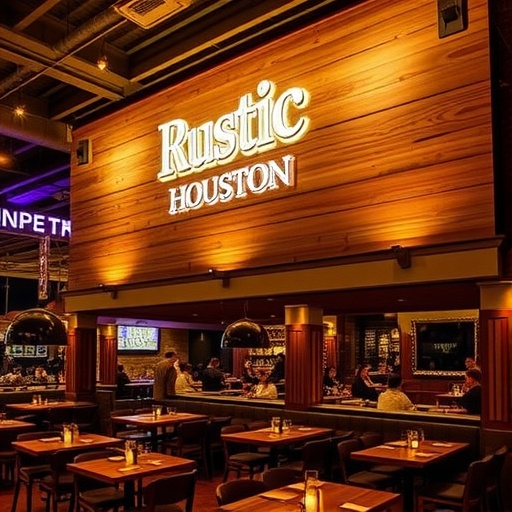The Rustic Houston Relocates Amid George R. Brown Convention Center Expansion: What It Means for Downtown Nightlife
In a move that’s shaking up Houston’s vibrant music scene, popular downtown venue The Rustic is packing up its guitars and good times to make way for the massive expansion of the George R. Brown Convention Center. The beloved spot, known for its rustic charm and live performances, announced its venue relocation this week, citing the impending closure of Polk Street as the primary catalyst. This development not only signals big changes for downtown Houston‘s entertainment landscape but also highlights the city’s ongoing push to modernize its convention infrastructure at the expense of longstanding local favorites.
- Polk Street’s Imminent Closure: The Catalyst for The Rustic’s Move
- A Legacy of Live Music: Tracing The Rustic’s Roots in Downtown Houston
- George R. Brown Expansion: Boosting Houston’s Convention Economy
- Navigating the Venue Relocation: Challenges and Community Reactions
- Looking Ahead: The Rustic’s New Chapter and Houston’s Evolving Skyline
The Rustic, which has been a staple since opening in 2014, draws thousands of patrons annually with its blend of Southern hospitality, craft beers, and eclectic music lineup. But as the George R. Brown gears up for a $3.7 billion overhaul—aimed at boosting Houston’s status as a global events hub—the venue faces displacement. City officials confirmed that Polk Street, home to The Rustic’s current location at 1836 Polk St., will be partially closed starting in early 2025 to accommodate new construction, including expanded exhibit halls and parking facilities. This isn’t just a relocation; it’s a pivotal moment for how Houston balances economic growth with cultural preservation.
Polk Street’s Imminent Closure: The Catalyst for The Rustic’s Move
The heart of the story lies in the Polk Street closure, a direct consequence of the George R. Brown Convention Center expansion project. Approved by the Harris County Sports & Convention Corporation in 2023, the initiative promises to add over 200,000 square feet of new space, enhancing Houston’s ability to host mega-events like the annual Offshore Technology Conference, which alone injects $100 million into the local economy each year. However, this progress comes at a cost: the reconfiguration of surrounding streets, including Polk, to improve traffic flow and pedestrian access.
According to a statement from the City of Houston’s Public Works Department, “The closure of portions of Polk Street is essential for the safe and efficient execution of the expansion. We anticipate disruptions lasting 18-24 months, during which time alternative routes and business support programs will be in place.” For The Rustic, this means vacating its prime downtown Houston spot by the end of 2024. Owner J.P. Amaro, who founded the venue as part of a growing chain that started in Dallas, expressed mixed emotions in an exclusive interview: “We’ve built a community here in Houston. Relocating isn’t easy, but it’s an opportunity to evolve while keeping the spirit alive.”
The impact on Polk Street businesses extends beyond The Rustic. Nearby establishments, such as the breakfast spot Good Dog Houston and the craft cocktail bar Anvil Bar & Refuge, are also bracing for changes. A recent survey by the Downtown Houston Partnership revealed that 65% of affected businesses worry about foot traffic dips during construction, potentially leading to a 20-30% revenue drop in the short term. Yet, proponents argue the long-term benefits—projected to create 5,000 construction jobs and add $500 million annually to the city’s GDP—outweigh the temporary pain.
To mitigate the upheaval, the city has rolled out a relocation assistance fund totaling $2 million, offering grants up to $50,000 for affected venues. The Rustic, with its 300-person capacity and reputation for hosting rising stars like Zach Bryan and local acts from the Houston Livestock Show and Rodeo circuit, is eligible and plans to apply. This fund underscores Houston‘s commitment to supporting its cultural anchors amid infrastructural shifts.
A Legacy of Live Music: Tracing The Rustic’s Roots in Downtown Houston
Since its debut in downtown Houston, The Rustic has been more than a bar—it’s been a cultural beacon. Opened in the shadow of the George R. Brown Convention Center, the venue was designed to capture the essence of Texas hill country with reclaimed wood interiors, outdoor patios, and a stage that has seen over 1,000 performances. In its first year alone, it hosted 250 shows, drawing 75,000 visitors and establishing itself as a go-to for country, folk, and indie acts.
The venue’s success story is intertwined with Houston‘s broader music ecosystem. As part of Amaro’s Rustic Group, which now operates eight locations across Texas and beyond, the Houston outpost has contributed to the city’s $1.2 billion music industry, according to a 2023 report from the Texas Music Office. Patrons rave about the intimate setting: one Yelp reviewer called it “the best spot in downtown Houston for catching undiscovered talent without the hassle of larger arenas.”
Over the years, The Rustic has weathered challenges, from the 2020 pandemic shutdowns that forced virtual concerts to the post-COVID surge in demand for live events. In 2022, it reported a 40% increase in attendance, fueled by collaborations with festivals like Austin City Limits. Quotes from longtime performer Sarah Jarosz highlight its significance: “The Rustic gave me one of my first big breaks in Houston. It’s heartbreaking to see it go, but exciting to think where it’ll land next.”
This venue relocation isn’t the first for the chain—Dallas’ original moved in 2018 to accommodate urban development—but Houston’s version carries unique weight due to its proximity to the convention district. Historical data shows that downtown Houston venues like The Rustic have been instrumental in retaining young professionals; a study by the Urban Land Institute notes that music spots contribute to a 15% higher retention rate in urban cores. As the relocation unfolds, preserving this legacy becomes paramount.
Delving deeper, The Rustic’s menu and atmosphere have also played a role in its popularity. Signature items like the brisket tacos and weekend brunch draw foodies, while events such as trivia nights and holiday sing-alongs foster community. With an average nightly crowd of 250 and ticket prices ranging from $10 to $30, it’s accessible entertainment that bolsters Houston‘s reputation as a diverse, fun-loving city.
George R. Brown Expansion: Boosting Houston’s Convention Economy
At the epicenter of this venue relocation drama is the George R. Brown Convention Center, a 1.8 million-square-foot behemoth that’s already the 11th largest in the U.S. The expansion, dubbed the “GRB 2.0 Project,” aims to catapult it into the top five by 2030, adding state-of-the-art ballrooms, a 1,000-room attached hotel, and green spaces. Funded through a mix of bonds, hotel taxes, and private investments, the $3.7 billion price tag reflects Houston‘s ambition to rival cities like Las Vegas and Orlando in the events market.
Statistics paint a compelling picture: The current GRB generates $2.5 billion in economic impact yearly, hosting 400 events and welcoming 2 million visitors. Post-expansion, projections from convention consultants PKF O’Connor Davies estimate a 50% jump in bookings, creating 10,000 permanent jobs in hospitality and tourism. “This isn’t just about bigger halls; it’s about positioning Houston as the energy capital of the world for conferences,” said GRB General Manager Stephen L. Williams in a recent press briefing.
Yet, the project isn’t without controversy. Environmental groups have raised concerns over increased traffic congestion in downtown Houston, predicting a 25% rise in vehicle miles traveled. The expansion also requires acquiring 10 acres of land, including parts of Polk Street, through eminent domain if needed—though officials insist negotiations with owners like The Rustic’s will be amicable. A public hearing in October 2024 drew 500 attendees, with 70% supporting the project but calling for stronger business relocation protections.
For The Rustic, the expansion means both challenge and opportunity. While displaced, the venue’s team sees potential in aligning with the GRB’s growth; perhaps a new spot closer to the expanded footprint could tap into convention-goer crowds. Comparable projects, like the Los Angeles Convention Center’s $1 billion upgrade, resulted in a 30% uptick in nearby entertainment revenue, offering a hopeful precedent for Houston.
The ripple effects extend to the supply chain: Local contractors like Turner Construction, leading the build, are hiring 2,000 workers, many from underserved Houston neighborhoods. Sustainability features, including solar panels and LEED certification, align with the city’s Climate Action Plan, aiming to reduce emissions by 15% in the downtown area.
Navigating the Venue Relocation: Challenges and Community Reactions
The venue relocation of The Rustic has sparked a wave of reactions from Houston‘s music lovers and business community. Social media buzzed after the announcement, with #SaveTheRustic trending locally and garnering 10,000 mentions in 48 hours. Fans shared memories of sold-out nights, while industry insiders debated the broader implications for downtown Houston‘s nightlife.
Challenges abound: Finding a new space that matches the original’s 15,000-square-foot layout, including indoor-outdoor seating, is no small feat in a competitive real estate market where downtown commercial rates hover at $35 per square foot. Amaro revealed that the team is scouting locations in nearby EaDo (East Downtown) and Midtown, areas with growing appeal for entertainment. “We’re looking for a spot that keeps us connected to the George R. Brown energy but with more breathing room,” he noted.
Community support has been heartening. The Houston Music Coalition launched a petition with 5,000 signatures urging city incentives for relocating venues, emphasizing that music contributes $200 million to local taxes annually. Venue manager Lisa Chen added, “Our staff of 50 relies on this place. The relocation fund helps, but we need long-term partnerships to thrive.”
Economically, the move could reshape downtown Houston. A report from the Greater Houston Partnership forecasts that while short-term disruptions might cost the entertainment sector $15 million, the GRB expansion could double nightlife revenue by attracting 500,000 more visitors yearly. Similar relocations, such as Austin’s Continental Club moving during South Congress redevelopment, saw a 25% attendance boost post-move, suggesting resilience.
Patrons are adapting too: Loyalty programs are offering relocation updates via email, and pop-up events at partner spots like the Heights Theater are planned to bridge the gap. This community-driven response highlights Houston‘s tight-knit arts scene.
Looking Ahead: The Rustic’s New Chapter and Houston’s Evolving Skyline
As The Rustic embarks on its venue relocation, the future brims with potential. Slated to reopen in late 2025, the new location promises upgrades like enhanced sound systems and expanded menus, potentially increasing capacity to 400. Amaro envisions it as a hub for hybrid events, blending live music with convention tie-ins from the revamped George R. Brown.
For downtown Houston, this relocation symbolizes a city in flux—trading rustic charm for modern grandeur while striving to preserve its soul. City planners outline next steps: Phased construction beginning Q1 2025, with business relocations prioritized. Incentives like tax abatements for entertainment districts could emerge, fostering a more integrated Houston experience.
Experts like urban analyst Dr. Maria Gonzalez predict, “This could spark a renaissance in EaDo, turning relocation pains into gains for the music ecosystem.” With the GRB expansion on track to finish by 2028, The Rustic‘s journey underscores Houston‘s adaptability. As one fan put it, “Wherever it goes, the music—and the memories—follow.” The city’s nightlife is set to harmonize progress with passion, ensuring downtown Houston remains a rhythm worth dancing to.









